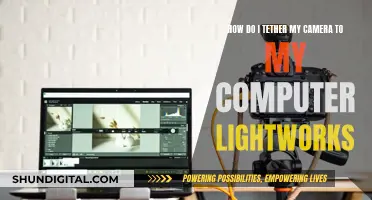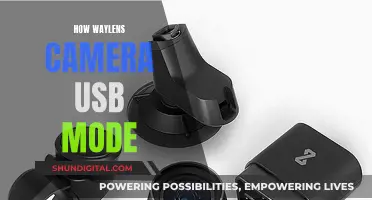
Focus bracketing is a feature that allows a camera to take a series of images in quick succession, with the focus distance changing incrementally between each shot. This feature is particularly useful for macro photography, where the depth of field is extremely shallow at close focus distances, and for landscape photography, where photographers may want to keep an entire scene in focus. Canon introduced the focus bracketing feature in the Canon EOS RP mirrorless interchangeable lens camera, and it is now available on many additional models. Other Canon cameras that have focus bracketing include the Canon EOS R3, Canon EOS R5, Canon EOS R6 Mark II, Canon EOS R6, Canon EOS R7, Canon EOS R10, Canon EOS 90D, Canon EOS M6 Mark II, and Canon PowerShot G5 X Mark II.
| Characteristics | Values |
|---|---|
| Camera model | Canon EOS R3, Canon EOS R5, Canon EOS R6 Mark II, Canon EOS R6, Canon EOS RP, Canon EOS R7, Canon EOS R10, Canon EOS 90D, Canon EOS M6 Mark II, Canon PowerShot G5 X Mark II, Canon PowerShot G7 X Mark III |
| Number of images | Up to 999 |
| Focus increment | 1-10 |
| Exposure smoothing | Enable/Disable |
What You'll Learn

Canon EOS RP
The Canon EOS RP is a full-frame mirrorless camera that was first introduced in early 2019. It is the lightest and most compact full-frame EOS camera to date. The EOS RP has a 26.2 MP CMOS sensor, fast and accurate autofocus, 4K video, and a DIGIC 8 processor for exceptional results, even in low light.
The EOS RP has a Dual Pixel CMOS AF for fast and accurate autofocus. The camera's autofocus system can achieve focus in approx. 0.05 seconds. The autofocus system has an AF area of approx. 88% x 100%, which means fast and impressive focusing even for off-centre subjects. The autofocus system can also operate in light ratings as low as EV -5. The camera also has a range of sophisticated AF modes to achieve sharp focus to suit specific subjects and situations.
The EOS RP has a built-in EVF with 2.36 million dots and Touch & Drag AF. The camera also has a 3.0-inch vari-angle touchscreen LCD screen. The EOS RP has a maximum webcam image resolution. The camera is compatible with RF, Canon EF-S, and Canon EF lenses.
The EOS RP has four settings to control the focus bracketing feature:
- Activate Focus Bracketing (Enable/Disable)
- Input number of shots (2 to 999)
- Focus increment (1-10)
- Exposure smoothing (Enable/Disable)
The Evolution of Contax Cameras: A Global Journey
You may want to see also

Canon EOS R5
The Canon EOS R5 also has a focus bracketing feature, which was first introduced in the Canon EOS RP mirrorless interchangeable lens camera. When enabled, the focus bracketing feature takes a series of pictures with the lens's focus distance setting increasing between each image captured until the specified number of images are captured or until infinity focus is reached. The resulting set of images can then be focus-stacked during post-processing, resulting in an increased depth of field. This technique is commonly used in macro photography and landscape photography.
There are four settings used to control the focus bracketing feature:
- Activate Focus Bracketing (Enable/Disable)
- Input number of shots (2 to 999)
- Focus increment (1-10)
- Exposure smoothing (Enable/Disable)
The number of shots instructs the camera to capture up to the specified number of images. However, the camera will stop taking photographs when infinity focus distance is reached, which may require fewer images than specified. The focus increment setting deals with the granularity of the focus distance adjustment between each shot, with 1 requesting fine increments and 10 requesting wide increments. Exposure smoothing is disabled by default but can be enabled to keep image brightness consistent through the image set.
It is recommended to use a tripod when using the focus bracketing feature, and only creative zone exposure modes are supported (P, Tv, Av, Fv, or M). In M or Av mode, any aperture can be selected, but a relatively narrow aperture such as f/8 or f/11 reduces the number of shots needed. The lens must be in AF mode for focus bracketing to work, and any subjects that are in motion during the bracketing capture may create ghosting in the final image.
History of Brownie Starlet: The Iconic Camera's Evolution
You may want to see also

Canon EOS R6
The Canon EOS R6 offers a focus bracketing feature, which allows you to take a series of pictures with the lens's focus distance setting increasing between each image captured. This technique is particularly useful for macro photography and landscape photography, where the depth of field is shallow or you want to keep the entire scene in focus.
To use focus bracketing on the Canon EOS R6, first set the feature to Enable. Then, input the number of shots you want to take (between 2 and 999). Next, set the focus increment, which determines how much the focus shifts between each shot. Finally, you can set the exposure smoothing to Enable to keep the image brightness consistent across the set.
Once you have adjusted these settings, you can start shooting. The camera will automatically change the focal distance after each shot, moving towards infinity. You can stop shooting at any time by pressing the shutter button again.
After capturing the images, you can use software such as Canon's Digital Photo Professional to create a composite image with a greater depth of field. This process is known as focus stacking.
Galaxy S7 Camera Mode Mystery: Where Did It Go?
You may want to see also

Canon EOS R7
The Canon EOS R7 is a camera with focus bracketing capabilities. Focus bracketing is a feature that enables the camera to take a series of pictures with the lens's focus distance setting increasing between each image captured. The resulting set of images can then be focus-stacked during post-processing, resulting in an image with a greater depth of field.
To use focus bracketing on the Canon EOS R7, you need to first activate the feature by enabling it in the settings. You can then specify the number of shots you want to capture, which can be set between 2 and 999. The focus increment setting allows you to adjust how much the focus shifts between each shot, with 1 requesting fine increments and 10 requesting wide increments. You can also enable exposure smoothing to compensate for changes in image brightness during focus bracketing.
The Canon EOS R7 also introduces in-camera depth compositing, which means that the camera can automatically stack and crop the depth-composite images during focus bracketing. This feature is especially useful for macro photography and landscape photography, where the depth of field is typically very narrow or when you want to achieve front-to-back sharpness.
It is important to note that focus bracketing is intended for still photo shooting on a tripod and it is recommended to use a wider angle of view when shooting. Additionally, flash photography is not available when using focus bracketing, and shooting under flickering light may cause uneven images.
Paying Bus Camera Tickets: MD Options
You may want to see also

Canon EOS R10
The Canon EOS R10 is a mirrorless camera that supports focus bracketing. Focus bracketing is a technique where the camera takes a series of pictures with the lens's focus distance setting increasing between each image captured until the specified number of images are captured or until infinity focus is reached. The Canon EOS R10's focus bracketing feature enables continuous shooting with the focal distance changed automatically after each shot. The number of shots can be set to anywhere between 2 and 999. The focus increment setting deals with the granularity of the focus distance adjustment between each shot, with 1 requesting fine increments and 10 requesting wide increments.
The Canon EOS R10's focus bracketing feature is especially useful for macro photography, where the depth of field is typically extremely shallow at close focus distances. It is also helpful for landscape photography, where the entire scene, including a close foreground subject, needs to be in focus.
The Canon EOS R10 also introduces in-camera depth compositing and cropping of depth-composite images, enabling photographers to check the results immediately. This feature is called Depth Composite in the camera's Focus Bracketing menu, and it enables photographers to combine their captured images as a single JPEG while also saving the individual source frames. When depth compositing is enabled, the Crop depth function can be used to automatically trim the image.
The Canon EOS R10's focus bracketing feature is best used on a tripod to ensure that the series of images are perfectly aligned.
Labeling Camera Batteries: A Quick Guide to Best Practices
You may want to see also







